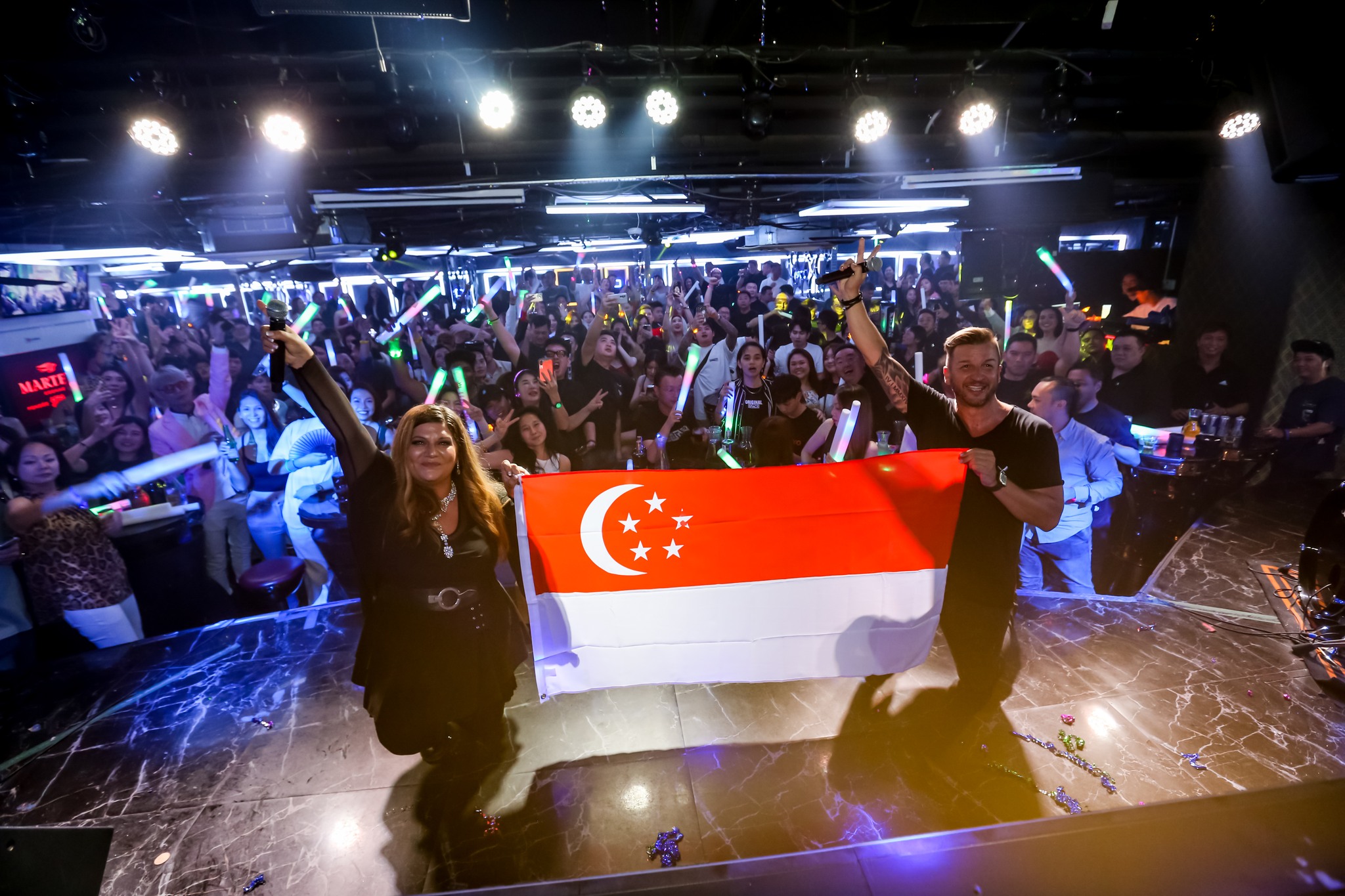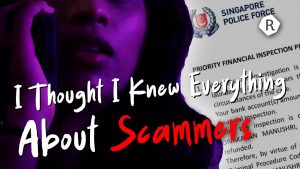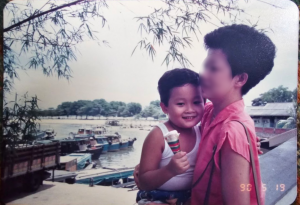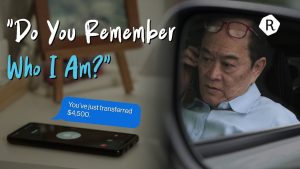Top image: Club Axis Singapore / Facebook
Groove Coverage has a problem. The German trance music outfit was just given an ultimatum: forgo performing their hit single ‘Million Tears’ at their Singapore gig or find a solution to prevent the crowd from chanting gang slogans.
This isn’t a problem for Groove Coverage in Germany or Hungary, the previous stops of their 2023 world tour. The only country in the world where they face this problem is Singapore.
ADVERTISEMENT
The issue lies in the crowd’s reaction. The song ‘Million Tears’ is a cue for Singaporean audiences to break into a gang chant when it gets played out loud, ironically or unironically. The chant itself has roots in the customs of Salakau (Hokkien for ‘369’), the infamous secret society that has been active here since the 1970s.
It’s not the first rodeo for Groove Coverage—they faced the same hurdle in 2019 when they played at River Valley nightclub District 9. What’s different this time is they know how to navigate Singapore’s rules while still delivering a good show for their sold-out crowd.
Outside Club Axis, at the basement of Parklane Shopping Mall in September this year, loud ah bengs and ah lians sporting slicked-back pompadours and oversized T-shirts await for the show to start.
But mostly to hear ‘Million Tears’ played live.
I Wanna Know Where You Belong
The song starts with soft synthesiser riffs, leading to an emotional ballad before the drum machine kicks in with a 4/4 beat. The chorus, deceptively simple yet infectious, reaches its zenith with a techno crescendo.
But more importantly, it fits nicely with the beat and rhythm of Salakau’s gang poem. When chanted to the song, each line of the poem is accentuated with its beats.
With the song, the chant’s lines seem to fill a larger space and take on a larger dimension. An almost ethereal quality is reached when chanting brash Hokkien mantras to the song. It’s addictive, it’s empowering, it’s energising.
“Whoa oh whoa ohh, a million tears for you,” Melanie Münch, Groove Coverage’s singer, belts out before the instrumental break. It’s also the cue for the Salakau gang chant to start.
My first brush with the song arrived on Recruits’ Night during National Service in 2017. The Eurodance song was, at first, unremarkable. Hear one trance song blasted from the back of an e-scooter as it whizzes past you, and you’ve heard all of them.
But that night, the song’s intro immediately resurrected the crowd’s interest. Army recruits, who until then had been in a blurry stupor, suddenly stirred to life.
When the song played over the speakers by a sergeant in charge of the aux cord, platoon mates contorted their fingers into strange arrangements before waving them in the air—the sergeant knew what he was doing. Collectively, they chanted quietly: “Seh ah! Seh ah! Seh ah! Seh ah! Seh!”
ADVERTISEMENT
I Wanna Know Why I Sing This Song
I would only learn of the song’s significance the next day, after a bunkmate’s generous gesture of goodwill to educate the ignorant (i.e. me). The explanation was, unfortunately, scant.
However, I discovered that the finger contortions alluded to an old secret society tradition of identifying fellow members with hand signs. Other probing questions on the song’s history and the gang chant met only dead ends.
How a Eurodance song became a mandatory accompaniment to gang affiliations is puzzling. However, the fact remains: ‘Million Tears’ and the Salakau gang chant are a natural pairing.
After the song was released in 2002, Singaporeans burnt it into CDs and put it on repeat on their discmans. And that dynamic between the song and the gang chant has endured since.
A YouTube video posted 11 years ago titled ‘Groove Coverage — Million Tears (Playboy Remix)’ has amassed about 1.3 million views thus far. You barely have to scroll deep into the comments section before you find a Singaporean.
“Ladies and gentlemen, please stand up for the Singapore National Anthem,” one comment posted in 2021 reads. “This song is what makes who Singaporeans are today,” another comment published in 2022 jokes.
ADVERTISEMENT
Perhaps this comment encapsulates it all: “Being Singaporean brought me here.”
Musically, only Kit Chan’s ‘Home’ can rouse the same hot-blooded patriotism as ‘Million Tears’. For comparison, one of the highest number of plays for a music video of ‘Home’ is 2.3 million.
Finding out how many Singaporeans are behind the views of the multiple ‘Million Tears’ YouTube clips is difficult. But the fact that a German dance song holds a candle to ‘Home’ is its own achievement.
I Tried to Show How Much I Feel
Groove Coverage is back home in Germany; they recently finished another show in Hungary. Like their upbeat tunes, their enthusiasm is overpowering. It shines through raspy voices and wearied postures.
“After we arrived in Singapore in 2019, the [concert organiser] told us there was a little problem with the chanting. We are European musicians and hadn’t heard about the chanting before,” DJ Novus of Groove Coverage explains.
“The organiser [in Singapore] told us they were unsure whether we could do the song, but everybody loved it. It was one of the reasons why they invited us. Maybe you can tell us its history?”
The history of ‘Million Tears’ begins in 2002, when it was written within three days. Groove Coverage tells me it was one of the first songs they ever wrote, produced and recorded for their album Covergirl.
“Funnily enough, there were no challenges when writing the song. It just flowed.”
A national cult following for three days’ work? One can only dream. But no one, not even Groove Coverage themselves, could have anticipated its popularity in Singapore, oceans away from Germany.
Audience members at Club Axis so desperately wanted to hear the song that they agreed to a compromise. Any parts of the chant with gang affiliations were left out. They could chant to other songs. And that’s what they did throughout the show, only pausing when ‘Million Tears was played’.
“We did the song twice. It was a very good reception,” DJ Novus tells me.
However, this raises the question: What makes’ Million Tears’ so unique if the audience could chant the same chant with any other song?
So Many Tears I’ve Cried For You
“It might have to do with the word ‘belong’,” a former gang member who spoke to RICE on condition of anonymity clarifies. “The song creates a sense of camaraderie,” he continues.
ADVERTISEMENT
His answer illustrates a deeply intertwined history between ‘Million Tears’ and the Salakau gang chant. According to him, members rally around the gang chant as much as they do around the song.
“To my knowledge, all gangs have a soundtrack to their gang poems and chants—there’s a very goosebumpy feeling because it’s just a reminder of who we are.”
The song, however, is less about belonging and more about a broken heart, Groove Coverage reveals.
“The song is a romantic story about heartache. When you have your first big heartbreak, your first love leaves you, and you feel so much pain,” Melanie and DJ Novus of Groove Coverage explain.
“It’s a love song. We are very well known for emotional dance music. It’s powerful. It’s dance and also emotional. We wanted to combine the two genres together.”
No one knows who was the first to combine both, but the Groove Coverage song and the gang chant feed off each other, propelling ‘Million Tears’ to greater popularity. Over time, any Singaporean who learns of ‘Million Tears’ eventually learns of its accompanying gang chant, and vice versa—just as I did during National Service.
While the former gang member admits that he’s strangely proud to see Singaporeans know the gang chant, it also feels weird to him that children can learn the chant as quickly as they can find the song on YouTube.
I Never Knew Where You Belong
As omnipresent as it is today, dance music wasn’t always this popular in Singapore; the genre ran through the country’s underground, evading mainstream tastes. Back then, syncopated electronic beats carried a negative connotation—it was thought to be enjoyed by delinquent youths.
Economic progress was at the top of Singapore’s to-do list when Singapore was still a budding nation in the 1960s and 1970s. Anything that goes against this collective mindset towards serious, productive industrialisation = bad.
ADVERTISEMENT
Emerging Western influences like rock music, with its emphasis on individualism, posed problems for the nation-building project. Dance music, which values self-expression, was viewed in the same light.
Then Minister for Home Affairs, Chua Sian Hin, captured this sentiment in his warning to nightclubs in Singapore in 1973.
“I am informed that our discotheques are places which are predominantly patronised by local youths, especially long-haired teenagers, who go there to revel in star-wandering rock and soul-moving music in a hallucinatory atmosphere so familiar with the drug and hippie cult.”
It was in the 1990s that dance music gained a bigger footing when Singapore gained economic stability and shifted its focus towards becoming a cultural capital as well as an economic powerhouse. It was a long time coming—Singapore’s first discotheque, Gino’s A-Go-Go, opened its doors in 1966.
Household names, some of which still exist today, found their footing in the dance music’s golden decade. Zouk opened its doors along the famous Jiak Kim Street in 1991; Sparks Disco welcomed merry-makers on Ngee Ann City’s seventh floor in 1993 before it shuttered.
Is It A Lie Or Is It True?
On the other hand, Salakau had always remained an active secret society, involved in illegal activities such as narcotics, extortion, and prostitution.
Singaporean youths looking for a place to belong joined its ranks. Former gang members tell me they were looking for a sense of belonging—they rejected the mainstream discourse and felt alienated from the nation-building project at the time.
It is unknown when the infamous gang chant exactly started, but gang poems such as Salakau’s are a mainstay feature for local secret societies. Former members reveal that the gang poems were used as a form of identification.
After they offered an ang bao to their would-be gang leader and pledged their loyalty to the society, gang poems were next on the orientation package.
Parts of the poem, which Singaporeans chant to techno now, carry a 200-year-old history—the first secret society in Singapore, Tiandihui (The Heaven and Earth Society), can be traced back to the 18th century.
Back then, secret societies had much more complex ceremonies. Society members identified each other with hand signs, memorised codes of conduct, and knew by heart what the position of tea cups meant during settlement talks over turf and territory. Gang poems were part of all of that.
According to one former gang member, the ceremonies were so complex that smaller groups, having grown tired of the ceremonies, broke off from the secret societies.
ADVERTISEMENT
These smaller groups eventually became street-corner gangs while still retaining the name of their parent secret society, like Salakau. The street-corner gangs did away with some ceremonies, but the tradition of the gang poem remains.
A Million Tears That I Have Cried
Gang chants and techno music would eventually cross paths in the rising nightclub scene in the 1990s.
“To my knowledge, there were mainly three secret societies who frequented Sparks Disco. One of them was Salakau. I think it started there,” another former gang member tells RICE.
“They would chant their gang poems, and if one of them got too loud, there would be trouble. I am not entirely sure, but chanting to songs started in nightclubs in the ‘80s and ‘90s.”
The warning from the then Home Affairs Minister became a validating belief. Perhaps young Singaporeans at the time who already saw themselves as outsiders were led to and eventually embraced dance music back in its days as an underground subculture.
Some of the people who frequented those nightclubs had pre-existing gang affiliations. Being an outsider led them to find kindred spirits in secret societies. That same sense of belonging was again found in the nightclub, emboldened in unity against the governmental finger-wagging.
And when they went to the clubs, they chanted their gang affiliations in a show of bravado. Perhaps, in one of those nightclubs, gang members had taken a liking to ‘Million Tears’ after its release in 2002 and took that as a cue to chant to that song.
Those chants were also interpreted as taunts. Rival gang chants were seen as provocations. And provocations led to arguments and all-out brawls.
In the early 2000s, the solution seemed simple: Stop the fights at its source.
It’s no wonder Groove Coverage faced problems that they had little part to play in. No one wanted a repeat of the same scenes from the early 2000s.
Nightclubs like Sparks Disco were places where informal customs, like chanting to ‘Million Tears’, were created. Today, they stand as grand old traditions.
ADVERTISEMENT
Different techno songs cued different chants, as corroborated by Alvinology Media. According to one of the former gang members, ‘Crazy Baby’ by Fantasy Project is another techno song complete with its own accompanying chant by the 18 Siao gang.
It was in places like Sparks Disco that gave rise to the association between ‘Million Tears’ and the Salakau gang chant. In some ways, it was inevitable.
A Million Tears For You
It was inevitable; it was a natural pairing. Gang chants united their members in their ‘other-ness’, and dance music, seen as an underground subculture back then, was simply another outlet. I like to think that the odd connection between Groove Coverage and Salakau is a canon event.
An invocation of ‘Million Tears’ harks back to simpler times, after all. It embodies a sense of camaraderie for those who were active in gangs in the old days. For others, the nostalgic kitsch of Eurodance reminds them of a time of ‘chiong-ing’ at legacy nightclubs like Zouk, Venom, and Canto.
That’s all Groove Coverage could have hoped for ‘Million Tears’, ‘God is a Girl’, ‘Moonlight Shadow’, and other songs in their discography.
“All we want is for you to have fun with our music. No problems or political stuff. If you have fun chanting, just do it. We don’t want to change the culture in Singapore,” Melanie shares.
“All we experienced was people having fun at our concert. I hope this doesn’t change.”
Clearly, ‘Million Tears’ holds a special place in Singaporeans’ hearts, especially for those in the know. Aside from its cultural significance to a particular street gang in Singapore, it is, simply put, a catchy song that embodies the energy of the early 2000s.
I ask the former gang member whether he still listens to ‘Million Tears’. He replies without hesitation.
“Always. Not just for gang-related stuff. It’s a classic.”






